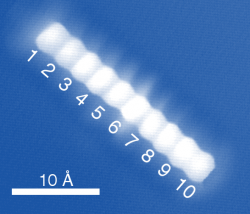Credit: Wiley
An international collaboration between synthetic chemists and surface scientists unveils a molecule formed by the linear fusion of 10 benzene rings, the longest acene prepared to date.
Acenes are molecules formed by the linear fusion of special carbon-based hexagons, widely known as 'benzene rings.' In spite of its structural simplicity, these molecules have attracted attention due to their unique electronic properties; for example, pentacene, which has five linear rings, is an organic semiconductor for building photoelectronic devices, while larger acenes present intriguing properties that have fascinated scientists for decades.
However, long acenes are unstable molecules, which have no natural sources. The obvious alternative is to develop these molecules via chemical synthesis, but this approach becomes more challenging as the length of the molecule increases. In fact, nonacene (with nine rings linearly fused) was the largest acene detected to date in 2010.
In a new paper that soon will be published in the international edition of Angewandte Chemie, scientists from CiQUS and the Institute for Materials Science have generated elusive decacene, a molecule formed by the linear fusion of 10 benzene rings, the longest acene ever prepared. Throughout this research collaboration, led by professors Diego Peña (CiQUS) and Francesca Moresco (TUD), chemists from CiQUS prepared stable decacene precursors by solution chemistry, while physicists from TUD used these precursors to prepare decacene on a gold surface under ultrahigh vacuum, which was required in order to stabilize this extremely reactive compound. As a result, individual decacene molecules were visualized by high-resolution scanning tunneling microscopy (STM).
Journal information: Angewandte Chemie
Provided by CORDIS






















